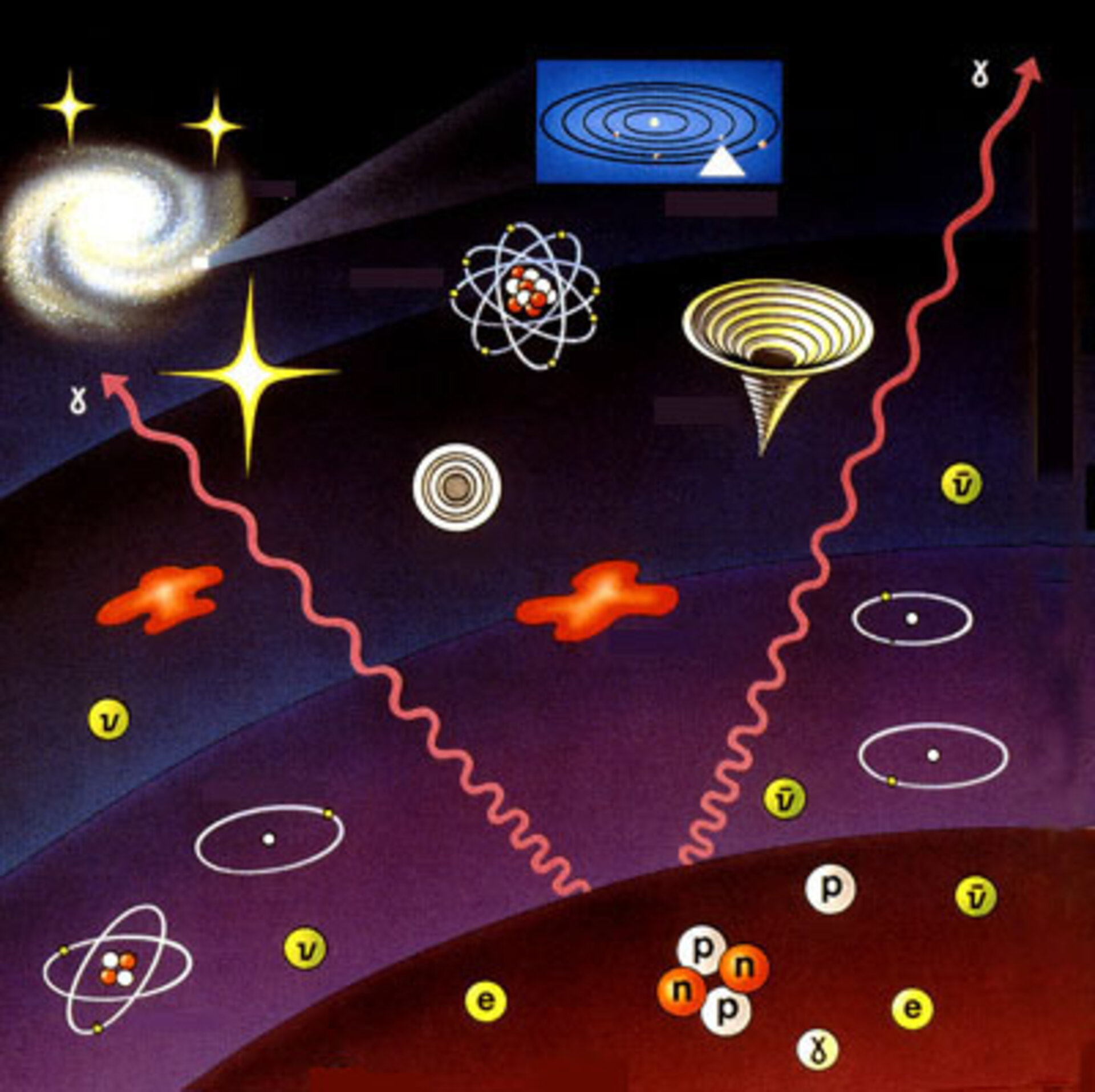So, how did everything start?
...a timeline for the Universe
Here is a brief 'potted' history of the first initial phase of the Universe and how it expanded to its current size from the so-called initial 'Big Bang' according to the most accepted current theory.
From 'zero time' to a millionth of a second
During this period, a very quick 'inflation' process takes place, and in an infinitesimal fraction of a second the cosmos becomes extremely large. All the matter and energy, concentrated in a region smaller than a coin, begins to expand at a very rapid rate. Once inflation is over, the Universe continues the expansion at a much slower pace. As it expands, it also cools.
When it is at a temperature of 1000 GeV (about 10 million million degrees), the forces of nature assume their present properties (such as gravity, electromagnetism, and the strong and weak forces) and the 'quarks', the elementary particles that are the building blocks of matter, wander freely.
This is the most accepted theory. For many scientists, this period is 'speculative'. There are no observations to confirm or disprove the theories.
A millionth of a second after the Big Bang
The Universe is roughly the size of our Solar System today, and the temperature drops to 1 GeV (10 thousand million degrees). It is cool enough for quarks to combine and make the particles in the atomic nucleus, protons and neutrons. These particles are called hadrons, so this period is often called the 'quark-hadron transition'.
From one second to three minutes after the Big Bang
At one second, the Universe grows to about a thousand times the size of our Solar System today and the temperature drops to 1 MeV, equivalent to 10 000 million degrees. Neutrons and protons combine to form the first nuclei: first deuterium, then helium and other elements. This is called 'primordial nucleosynthesis' and it lasts several minutes.
Three minutes after the Big Bang the temperature is a thousand million degrees. It is still too hot, however, for the atomic nuclei to capture electrons and form real elements.
From three minutes to 300 000 years after the Big Bang
The Universe keeps expanding. It is too hot yet for electrons to be captured by the atomic nuclei. Electrons wander freely and are therefore able to interact with the photons (light 'particles') as a result, light is trapped and cannot propagate more than a very short distance before encountering an electron. Therefore the Universe is opaque.
But about 300 000 years later, the Universe has cooled enough (to some 3000°C) to allow protons to capture electrons, and form neutral hydrogen atoms (in a phenomenon called 'recombination' or 'decoupling').
The Universe is about 1000 times smaller than its present size. Light can travel without hindrance: the Universe becomes transparent. The Cosmic Microwave Background radiation that we detect today is that 'first light'.
The dark ages
The matter is now cool. Initial clumps of matter start to grow by gravitational attraction. Scientists think that this process involves both the matter that we can see ('baryons') and so-called dark matter.
Based on theory, scientists assume that the first stars form when the lumps of matter grow to about 10 million times the mass of our Sun, when the Universe is about one thirtieth of its current size. The lumps of matter (containing stars) coalesce to form galaxies and clusters of galaxies.
The first stars produce lots of ultraviolet radiation which gradually ionises the neutral hydrogen (that is, liberating the electrons from the protons). This ends the dark ages and mark the transition to the reionisation era.
1 billion years after the Big Bang
The Universe is a fifth of its present size. Astronomical observations indicate that there are already fully formed galaxies. Therefore galaxy formation must have started much earlier. When the Universe is half its present size, the nuclear reactions inside the stars have already produced most of the chemical elements that are needed to make Earth-like planets.
9 billion years after the Big Bang
About 5 billion years ago, our Sun was formed from the collapse of a cloud of dust and gas, producing a very average- looking star.
The remnants from the formation of the Sun, swirling in a disk around our infant star, gradually coalesced into the planets that form part of our Solar System. 4500 million years ago, Earth and the inner planets formed with rocky mantles and molten interiors, while more distant planets become gaseous giants.
Around 700 million years later, life begins on Earth. The oldest fossils of living organisms (bacteria) found on Earth are 3800 million years old.















 Germany
Germany
 Austria
Austria
 Belgium
Belgium
 Denmark
Denmark
 Spain
Spain
 Estonia
Estonia
 Finland
Finland
 France
France
 Greece
Greece
 Hungary
Hungary
 Ireland
Ireland
 Italy
Italy
 Luxembourg
Luxembourg
 Norway
Norway
 The Netherlands
The Netherlands
 Poland
Poland
 Portugal
Portugal
 Czechia
Czechia
 Romania
Romania
 United Kingdom
United Kingdom
 Slovenia
Slovenia
 Sweden
Sweden
 Switzerland
Switzerland

























